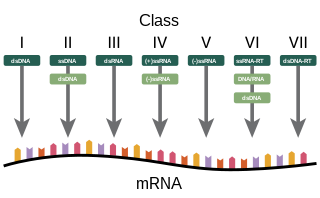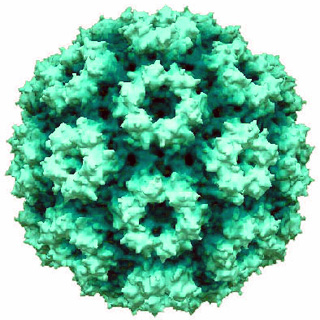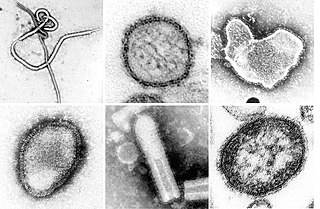
An RNA virus is a virus—other than a retrovirus—that has ribonucleic acid (RNA) as its genetic material. The nucleic acid is usually single-stranded RNA (ssRNA) but it may be double-stranded (dsRNA). Notable human diseases caused by RNA viruses include the common cold, influenza, SARS, MERS, Covid-19, Dengue Virus, hepatitis C, hepatitis E, West Nile fever, Ebola virus disease, rabies, polio, mumps, and measles.

Reoviridae is a family of double-stranded RNA viruses. Member viruses have a wide host range, including vertebrates, invertebrates, plants, protists and fungi. They lack lipid envelopes and package their segmented genome within multi-layered capsids. Lack of a lipid envelope has allowed three-dimensional structures of these large complex viruses to be obtained, revealing a structural and likely evolutionary relationship to the cystovirus family of bacteriophage. There are currently 97 species in this family, divided among 15 genera in two subfamilies. Reoviruses can affect the gastrointestinal system and respiratory tract. The name "reo-" is an acronym for "respiratory enteric orphan" viruses. The term "orphan virus" refers to the fact that some of these viruses have been observed not associated with any known disease. Even though viruses in the family Reoviridae have more recently been identified with various diseases, the original name is still used.

Geminiviridae is a family of plant viruses that encode their genetic information on a circular genome of single-stranded (ss) DNA. There are 520 species in this family, assigned to 14 genera. Diseases associated with this family include: bright yellow mosaic, yellow mosaic, yellow mottle, leaf curling, stunting, streaks, reduced yields. They have single-stranded circular DNA genomes encoding genes that diverge in both directions from a virion strand origin of replication. According to the Baltimore classification they are considered class II viruses. It is the largest known family of single stranded DNA viruses.

Totiviridae is a family of double-stranded RNA viruses. Giardia lamblia, leishmania, trichomonas vaginalis, and fungi serve as natural hosts. The name of the group derives from Latin toti which means undivided or whole. There are 28 species in this family, assigned to 5 genera.

Φ6 is the best-studied bacteriophage of the virus family Cystoviridae. It infects Pseudomonas bacteria. It has a three-part, segmented, double-stranded RNA genome, totalling ~13.5 kb in length. Φ6 and its relatives have a lipid membrane around their nucleocapsid, a rare trait among bacteriophages. It is a lytic phage, though under certain circumstances has been observed to display a delay in lysis which may be described as a "carrier state".

Baltimore classification is a system used to classify viruses based on their manner of messenger RNA (mRNA) synthesis. By organizing viruses based on their manner of mRNA production, it is possible to study viruses that behave similarly as a distinct group. Seven Baltimore groups are described that take into consideration whether the viral genome is made of deoxyribonucleic acid (DNA) or ribonucleic acid (RNA), whether the genome is single- or double-stranded, and whether the sense of a single-stranded RNA genome is positive or negative.

Cowpea chlorotic mottle virus, known by the abbreviation CCMV, is a virus that specifically infects the cowpea plant, or black-eyed pea. The leaves of infected plants develop yellow spots, hence the name "chlorotic". Similar to its "brother" virus, Cowpea mosaic virus (CPMV), CCMV is produced in high yield in plants. In the natural host, viral particles can be produced at 1–2 mg per gram of infected leaf tissue. Belonging to the bromovirus genus, cowpea chlorotic mottle virus (CCMV) is a small spherical plant virus. Other members of this genus include the brome mosaic virus (BMV) and the broad bean mottle virus (BBMV).

Partitiviridae is a family of double-stranded RNA viruses. Plants, fungi, and protozoa serve as natural hosts. It has been suggested that they can also infect bacteria. The name comes from the Latin partitius, which means divided, and refers to the segmented genome of partitiviruses. There are five genera and 60 species in the family, 15 of which are unassigned to a genus.
Asparagus virus 1 (AV-1) is one of the nine known viruses that affects asparagus plants. It is in the Potyviridae family. Initially reported by G. L Hein in 1960, it is a member of the genus Potyvirus and causes no distinct symptoms in asparagus plants. The only known plant that can get AV-1 is asparagus plants. It is spread by aphids vectors, which means that aphids do not cause the AV-1, but they do spread it.

Double-stranded RNA viruses are a polyphyletic group of viruses that have double-stranded genomes made of ribonucleic acid. The double-stranded genome is used to transcribe a positive-strand RNA by the viral RNA-dependent RNA polymerase (RdRp). The positive-strand RNA may be used as messenger RNA (mRNA) which can be translated into viral proteins by the host cell's ribosomes. The positive-strand RNA can also be replicated by the RdRp to create a new double-stranded viral genome.
Endornaviridae is a family of viruses. Plants, fungi, and oomycetes serve as natural hosts. There are 31 species in this family, assigned to 2 genera. Members of Alphaendornavirus infect plants, fungi and the oomycete Phytophthora sp., members of Betaendornavirus infect ascomycete fungi.

Aspiviridae, formerly Ophioviridae, is a family of segmented negative-strand RNA viruses which infect plants. Member viruses are characterized by an elongated and highly filamentous and flexible nucleocapsid with helical symmetry. It is a monotypic taxon containing only one genus, Ophiovirus. Aspiviridae is also the only family in the order Serpentovirales, which in turn is the only order in the class Milneviricetes.
Ipomovirus is a genus of positive-strand RNA viruses in the family Potyviridae. Member viruses infect plants and are transmitted by whiteflies. The name of the genus is derived from Ipomoea – the generic name of sweet potato. There are seven species in this genus.

Bidensovirus is a genus of single stranded DNA viruses that infect invertebrates. The species in this genus were originally classified in the family Parvoviridae but were moved to a new genus because of significant differences in the genomes.

Ortervirales is an order that contains all accepted species of single-stranded RNA viruses that replicate through a DNA intermediate and all accepted species of double-stranded DNA viruses that replicate through an RNA intermediate . The name is derived from the reverse of retro.

Negative-strand RNA viruses are a group of related viruses that have negative-sense, single-stranded genomes made of ribonucleic acid. They have genomes that act as complementary strands from which messenger RNA (mRNA) is synthesized by the viral enzyme RNA-dependent RNA polymerase (RdRp). During replication of the viral genome, RdRp synthesizes a positive-sense antigenome that it uses as a template to create genomic negative-sense RNA. Negative-strand RNA viruses also share a number of other characteristics: most contain a viral envelope that surrounds the capsid, which encases the viral genome, −ssRNA virus genomes are usually linear, and it is common for their genome to be segmented.

The Blueberry mosaic associated ophiovirus (B1MaV) is a plant virus which infects blueberry plants, causing a discoloration of the leaves of the plants in a mosaic-like pattern. The disease is found in blueberry plants in many regions of North America, as well as South America, Europe, New Zealand, and South Africa. Within these regions the virus is most often found in high blueberry-yielding areas, but can be spread to other locations. Blueberry mosaic associatedophiovirus is one of seven species in the genus Ophiovirus. It is a member of the Aspiviridae family, in the Serpentovirales order, and in the Milnevircetes class. The Ophioviridae viruses are characterized by a flexible and elongated nucleocapsid that is composed mostly of filamentous structures and is helically symmetrical. It also has a non-enveloped protein capsid that is capable of coiling around itself allowing for a super-coiled structure and the helical symmetry. The virus has the potential to be symptomatic or asymptomatic within plants causing the display of symptoms in only a few plants, but the ability to transmit the virus unknowingly in many plants. B1MaV often remains asymptomatic for long periods of time after initial infection allowing for blind transmission.

Monodnaviria is a realm of viruses that includes all single-stranded DNA viruses that encode an endonuclease of the HUH superfamily that initiates rolling circle replication of the circular viral genome. Viruses descended from such viruses are also included in the realm, including certain linear single-stranded DNA (ssDNA) viruses and circular double-stranded DNA (dsDNA) viruses. These atypical members typically replicate through means other than rolling circle replication.

Orthornavirae is a kingdom of viruses that have genomes made of ribonucleic acid (RNA), those genomes encoding an RNA-dependent RNA polymerase (RdRp). The RdRp is used to transcribe the viral RNA genome into messenger RNA (mRNA) and to replicate the genome. Viruses in this kingdom also share a number of characteristics involving evolution, including high rates of genetic mutations, recombinations, and reassortments.

Botourmiaviridae is a family of positive-strand RNA viruses which infect plants and fungi. The family includes four genera: Ourmiavirus, Botoulivirus, Magoulivirus and Scleroulivirus. Members of genus Ourmiavirus infect plants and the other genera infect fungi. The member viruses have genomes which range from 2900 to 4800 nucleotides.
















